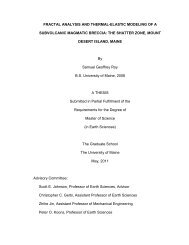Jumars, P.A. - University of Maine
Jumars, P.A. - University of Maine
Jumars, P.A. - University of Maine
You also want an ePaper? Increase the reach of your titles
YUMPU automatically turns print PDFs into web optimized ePapers that Google loves.
NEW SPECIES OF NORTH PACIFIC DORVILLEID POLYCHAETES 107<br />
Schistomeringos longicornis (Ehlers, 1901)<br />
(Fig . 2)<br />
Stauronereis longicornis Ehlers, 1901 : 150-1, pl . 19, figs 18-21, pl . 20,<br />
figs 4-6 .<br />
Stauronereis articulatus Hartman, 1938 : 101-2, figs 39-44 ; Rioja, 1941 :<br />
724-7, pl . 6, figs 10-18 .<br />
Dorvillea articulata : Hartman, 1944, 189, 1968, 817, figs 1-5 ; Rioja, 1947 :<br />
205 ; Reish, 1963 : 426 .<br />
Dorvillea rudolphi : Berkeley & Berkeley, 1948 : 86-7, figs 127-129 ;<br />
Fauchald, 1970 : 156-9, pl . 27, figs a-j, partim .<br />
Stauronereis rudolphi : Pettibone, 1963 : 231-3, fig . 60 a-f, partim .<br />
Dorvillea atlantica : Hartman, 1963 : 35 ; 1968 : 819, figs 1-5 .<br />
Material examined . The specimens considered by Hartman in her original<br />
(1938) description <strong>of</strong> Stauronereis articulatus were externally examined as<br />
follows : the holotype from Dillon Beach, Marin County (USNM 20363) ; two<br />
individuals from Point Conception, Santa Barbara County (AHF 3617) ; and,<br />
three examples from San Pedro, Los Angeles County (AHF 3618) . Five<br />
additional specimens from Point Vicente, Los Angeles County (AHF 4806-57,<br />
referred to S. articulatus by Hartman) were similarly treated, as were single<br />
specimens from each <strong>of</strong> the following localities in Washington and British<br />
Columbia (BCPM) : Massacre Bay near Orcas Island, Harney Pass near Orcas<br />
Island, Strait <strong>of</strong> Juan de Fuca, and Blubber Bay . Six specimens taken from the<br />
Coronado Canyon and referred to Dorvillea atlantica by Hartman (1963, 1968)<br />
were externally inspected and then dissected for pharyngeal examination .<br />
Remarks . Differences are observed in qualitative and quantitative characters<br />
among the populations <strong>of</strong> S . longicornis . For example, in the Coronado Canyon<br />
sample, two <strong>of</strong> the six specimens bear an aberrant type <strong>of</strong> seta among the<br />
normal compound ones (Fig . 2B, C) . These unusual setae are longer than the<br />
normal compound sort but completely lack the basal shaft . Hence a fraction <strong>of</strong><br />
this population bears simple setae below the neuroacicula . In addition, the eyes<br />
in this deep-water population are much less heavily pigmented than those <strong>of</strong><br />
the shallow-water forms . As Hobson notes (pers . comm .), furcate setae may not<br />
appear in specimens from the Pacific Northwest anterior to the fourth, fifth, or<br />
even fifteenth setiger .<br />
Although Pettibone (1963) and Fauchald (1970) include then under one<br />
name, confidence in the difference between the East Pacific and Mediterranean<br />
species stems from the fact that, despite the differences among populations<br />
within each <strong>of</strong> the species, they remain distinct on the basis <strong>of</strong> the tabled<br />
characters (Table 3) . This list is by no means exhaustive . For example, the<br />
species also differ in the shapes, sizes, and numbers <strong>of</strong> teeth on the anterior<br />
denticles <strong>of</strong> the superior rows and in the numbers <strong>of</strong> groups <strong>of</strong> teeth in the<br />
basal plates, but these differences are far more difficult to quantify than are the<br />
tabled features . Variability due to the age or size <strong>of</strong> the specimens must be<br />
extracted from these maxillary characteristics before they can be reliably<br />
employed in species discriminations . Similarly, S. rudolphi appears to have<br />
fewer compound setae per parapodium than does S. longicornis, but the<br />
difference is again confounded with relative sizes <strong>of</strong> the individuals, large
















